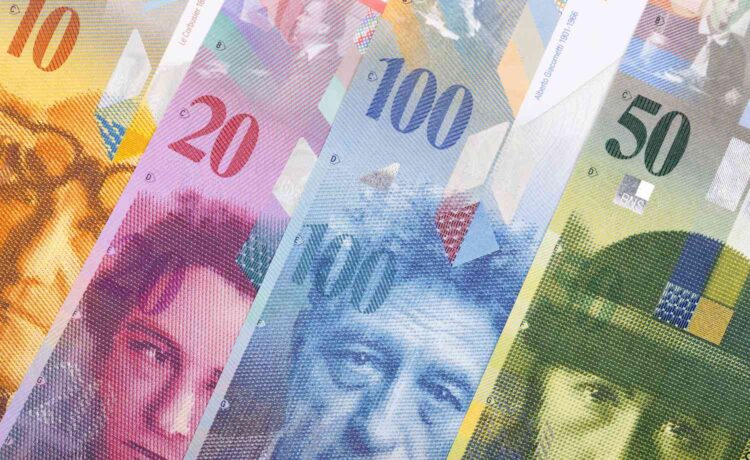What Is CHF (Swiss Franc)?
CHF is the abbreviation for the Swiss franc, the official legal tender of Switzerland, Liechtenstein, and the Italian region of Campione d’Italia. CHF stands for Confoederatio Helvetica franc, the Latin name for the Swiss Confederation. Banknotes are issued by the Swiss National Bank and coins are issued by Swissmint, the federal mint.
CHF is the only franc that’s still issued in Europe after the other nations that denominated their currencies in francs adopted the euro. The Swiss franc is often called the swissie by currency market traders. It’s the eighth most traded currency in the world.
Key Takeaways
- CHF is the abbreviation for the Swiss franc, which is the official currency of Switzerland, Liechtenstein, and Campione d’Italia.
- CHF is the only franc that’s still issued in Europe after the other nations that denominated their currencies in francs adopted the euro.
- CHF’s popularity stems from its status as a perennial safe-haven currency.
- CHF was briefly pegged to the euro between 2011 and 2015.
Understanding CHF (Swiss Franc)
The currency market, also known as the foreign exchange market or forex, is the largest financial market in the world. It boasted a daily average volume of more than $6.6 trillion in July 2024. The Swiss franc makes up a large portion of this volume.
The Swiss franc’s popularity stems from its status as a perennial safe haven currency. Many governments and other entities hold the currency as a buffer against instability in various types of markets and investments.
The currency’s stability is the result of several factors including Switzerland’s history of political stability, its strong rule of law, its neutral stance regarding foreign affairs, and its Western approach to business affairs. Inflation in Switzerland has been relatively low over the years.
Switzerland’s government and the Swiss National Bank (SNB) are also traditionally non-interventionist. The Swiss franc is not a reserve currency, however. Foreign trade involving Switzerland is typically settled in euros or U.S. dollars, not in Swiss francs.
The Swiss Franc Peg
The demand for the Swiss franc as a safe haven substantially increases its value in the global foreign exchange markets. The demand for the currency as a safe haven soared in the years following the 2008 financial crisis. The SNB had USD 884 billion (CHF 797 billion) in foreign exchange reserves as of Q1 2024. Switzerland’s foreign exchange reserves were equal to about 88% of its GDP at the close of 2023.
The high value of the currency makes foreign goods cheap in Switzerland but it hurts domestic exporters and the Swiss tourism industry because it makes the purchase of Swiss manufactured goods and services more expensive.
The flight to safety into the Swiss franc by global investors after the financial crisis was hurting Switzerland’s economy because it’s so heavily dependent on exports and tourism. The Swiss National Bank broke with tradition when it abandoned the float and pegged the swissie to the euro in September 2011. The fix was set at 1.2000 Swiss francs per euro. The SNB defended the peg with open market sales of the swissie to maintain the peg on the forex market.
The SNB suddenly dropped the peg and allowed the currency to float in January 2015, wreaking havoc on stock and forex markets. Swiss stocks tumbled dramatically while the Swiss franc soared about 25% to 30% relative to the euro within minutes. Some investors and firms were wiped out.
Economists and investors strongly criticized the SNB’s actions for dropping the peg without warning and for implementing it in the first place. Its actions were also unpopular in Switzerland.
Investing in the Swiss Franc
The Swiss franc has long been regarded as a safe haven asset by investors due to the stability of the Swiss economy, particularly those worried about the turmoil in larger markets. It’s possible to gain CHF exposure by simply buying Swiss francs but this strategy may not be ideal for retail investors because it requires them to set up a forex account.
An alternative strategy would be to invest in exchange-traded funds that make investments in the Swiss currency. These funds can be traded through an ordinary brokerage account without the trouble of setting up a separate forex account. More adventurous traders can also bet on the franc through currency futures or options trades.
Those who are new to the currency market might consider enlisting the advice and services of a good forex broker.
Why Is the Swiss Franc a Safe Haven Currency?
The Swiss franc is considered a safe haven currency due to the perceived stability of the Swiss economy and political system and a relatively low inflation rate. Political turmoil and debt crises in the European Union and the United States have led some international investors to move wealth into the Swiss currency which tends to gain value against both the euro and the dollar.
Is the Swiss Franc Backed by Gold?
Switzerland doesn’t use the gold standard but the Swiss National Bank continues to maintain the world’s seventh-largest gold stockpile as of Q1 2024 with over 1,000 tons of the precious metal.
How Much Is the Swiss Franc Worth in U.S. Dollars?
The Swiss franc was worth $1.1664 U.S. dollars as of October 2024.
Is the Swiss Franc Stronger Than the U.S. Dollar?
The U.S. dollar has steadily lost value against the Swiss franc from 2019 through 2024, making the franc a stronger currency than the dollar.
The Bottom Line
The Swiss franc (CHF) is considered one of the world’s safest assets and is one of the most frequently traded currencies on the forex market. Investors can gain CHF exposure through ETFs, derivatives, or by simply buying Swiss francs on the forex market.

















